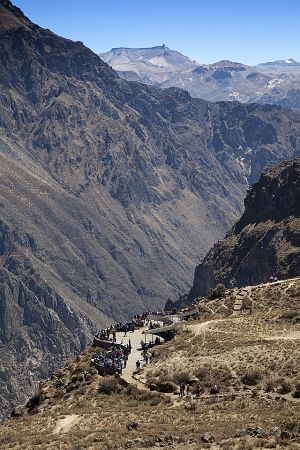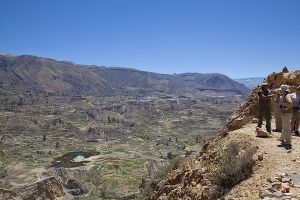Today is Cruz de Condor day – a 6 hour return trip out of Chivay to Colca Canyon, allowing for stops for small herds of sheep, goats, cows and donkeys to get past, in the hope of seeing condors in flight at Cruz de Condor. It turns out to be a vain hope – it is a virtually windless, bright sunny day.
No wind = no condors. Condors are a big, heavy bird (around 12 kg), and they need strong thermal currents to keep them airborne. Disappointing, but I figured that the universe was evening the score – perfect weather in South Georgia = no condors in Peru, and I’ll probably find that Lake Titicaca dries up overnight in readiness for my arrival tomorrow afternoon.
The condors are the national symbol of Peru, and are a sacred bird. Eagles are apparently not so sacred, and not protected. There is a worrying trend in the Colca Canyon for the locals to capture healthy eagles in traps using meat and stones, clip their wings, tie a string around their leg and use them to make money by charging stupid tourists to pose for photos with them. I’m all for the local community earning money, but not at the expense of mutilating these magnificent birds, who can no longer (and will never again) fly, or fend for themselves. Buy local handicrafts instead. In more than three villages, I saw two beautiful black-chested buzzard eagles and three variable hawks forced to flap their wings to maintain their balance on the arm of tourists posing for photos. My guide Abel estimated that there are 20 eagles being used in this way around the valley. These are not llamas with pretty colours around their necks and on their ears – these are wild animals who were given the gift of flight and have had it removed for the sake of a couple of dollars that could be obtained by other means. So, vistors to Colca Canyon – no photos con águila! (no photos with eagles), unless the eagle is free to fly. Save Peru’s Eagles!
Overall, the scenery in Colca Canyon is magnificent, with agricultural terraces dating back to before the Incas, with many ingenious means found to irrigate the fields using run-off from the moutain streams and rivers.





